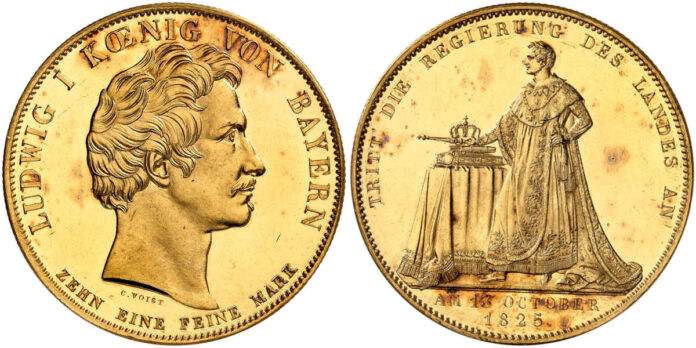
Ludwig I was an avid Philhellene, a lover of Ancient Greece. It was he who modelled Munich into an “Athens on the Isar”, which continues to attract millions of tourists every year. He had museums built in a style heavily influenced by classical antiquity. In Greece and Italy, he purchased the treasures that make Munich the major destination for ancient art that it is today. These include the sculptures from the Temple of Aphaia, the Barberini Faun and the Medusa Rondanini. Ludwig I wasn’t just an art collector. He also commissioned prominent artists to realise his creative ideas, which used ancient models as a basis for something new. The most famous example is probably the “Ruhmeshalle” (Hall of Fame) on the Theresienwiese, complete with the statue of Bavaria. The image of this structure is sent out across the world hundreds of thousands of times every year, in the backgrounds of countless selfies taken by merrymakers at Oktoberfest.

Ludwig I was a trendsetter who turned ancient ideas into modern infrastructure – and not just in the field of architecture. His most influential idea was to mint Roman-style coins, which served both as currency and as a means of disseminating his propaganda among the general public.
The Most Important Step on the Way to Modern Commemorative Coins
Of course, Ludwig I was not the first ruler to mint coins with motifs that fell outside the usual range of types. But his coins had a specific purpose. They were given as gifts in diplomatic relations and at special occasions such as weddings or funerals and/or as prizes in competitions.
Louis XIV of France was the first ruler to systematically circulate his propaganda several times a year in the form of medals. This model was imitated by many rulers of varying prominence.
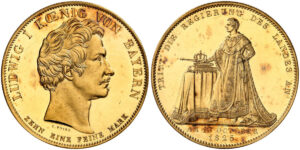
And then Ludwig I of Bavaria came up with the idea to start producing commemorative coins instead of medals, which could (at least in theory) circulate freely and thus spread his messages among the people. We know how hard the ruler himself worked to get these coins made. It was Ludwig who chose the themes and who corrected the designs, again and again, in countless editing processes.
This process is exemplified by the dies for the Geschichtstaler issued to mark Ludwig I of Bavaria’s accession to power, which were later used to mint the first of the seven gold off-metal strikes offered in this auction. Although the year on this piece reads 1825, the coins were not actually put into circulation until over a decade later in 1836. This delay was caused by the many changes requested by Ludwig. These modifications document how his liberal attitude changed in the course of everyday governance. While the Constitution of Bavaria forms the main focus of the initial draft design, in this final version, this theme is reduced to the image of a book, barely visible beneath the sceptre and crown.

The second gold off-metal strike offered by Numismatica Genevensis was made with the dies for what is probably the best-known Bavarian Geschichtstaler coin, which bears the inscription “Segen des Himmels” (“Blessing of Heaven”) and depicts all portraits of the royal family. This was an especially important theme for Ludwig. This die was one of the first two commissioned by him. By doing so, he was continuing an ancient tradition: Roman emperors used to promote their rule by depicting their sons on coins, since an heir (supposedly) guaranteed that no civil war would break out after the ruler’s death. Ludwig’s design should be interpreted in exactly the same way. The reason the image became so crucial was that the king himself had benefited from the two-time extinction of the ruling Bavarian dynasty: Max III Joseph died – taking the Bavarian branch of the House Wittelsbach with him – in 1777, and then the Palatinate branch of the House of Wittelsbach died out in 1799. Ludwig was descended from the Zweibrücken-Birkenfeld branch of the House of Wittelsbach.
On 9 October 1828, Ludwig approved the die design, but on one major condition: the Latin inscription had to be translated into German. This was a landmark decision. All subsequent Geschichtstalers would bear German inscriptions.
The coins were not put into circulation until 1831/2. The artist insisted on being allowed to portray all members of the royal family before making the die. Ludwig sent specimens of these coin to all the significant ruling houses of Europe. His idea was admired and widely adopted. The most famous imitations are the Russian family rubles, which imitate the “Segen des Himmels” Geschichtstaler in every detail.
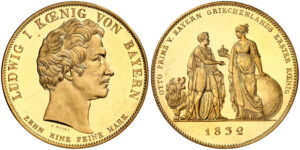
In the first half of the 19th century, the Kingdom of Bavaria was a middle power of international importance. The most successful foreign policy implemented by avid Philhellene Ludwig was his establishment of a “secundogeniture” in Greece. Since the three protecting powers of the young Greek nation – Russia, England and France – could not agree on which of the three ruling houses should be entitled to the Greek crown, Ludwig’s second-eldest son Otto became the compromise candidate. The advantage of this decision was that the prosperous state of Bavaria could provide large sums of money to advance the country’s development.
The Geschichtstaler dies, which were used to make this gold off-metal strike, depict a personification of Greece offering the crown to the 17-year-old king, representing the deputies of the Greek National Assembly who swore allegiance to Otto in Munich on 15 October 1832.
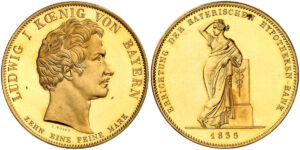
If you collect ancient coins, the motif on the Geschichtstaler whose die was used to make this gold off-metal strike may look strangely familiar. The lady dressed in ancient garb is reminiscent of the Roman goddess Securitas. Since ancient times, the image of Securitas has been used to symbolise the economic security of a country’s citizens. And that is precisely the message of the 1835 Geschichtstaler minted to mark the establishment of the Bayerische Hypotheken- und Wechselbank. According to this credit institution’s statutes, it had to spend three fifths of its deposits on 4% mortgages in rural areas. The aim of this policy was to make Bavarian agriculture competitive and thus ensure food security in Bavaria.
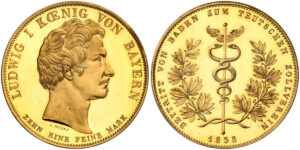
The dies for this Geschichtstaler are dedicated to Bavaria’s entry into the German Customs Union, an economic union that anticipated the political unification of Germany in the Second Empire of 1871. This design also takes inspiration from ancient motifs: in the 19th century, the caduceus or the Staff of Mercury developed into a symbol of free and profitable trade.
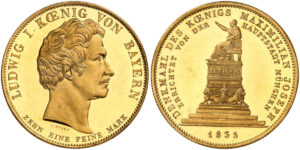
The dies for this gold off-metal strike are a testament to how determined Ludwig was to glorify the still rather brief history of his dynasty in numismatic form. In 1835, the monument to Ludwig’s royal father, Max I Joseph, was unveiled in front of the opera house. Ludwig made sure the coin indicated that it was the citizens of Munich who had realised the monument at their own expense.
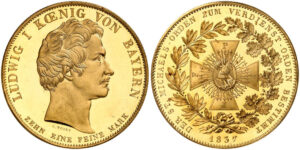
On 25 August 1837, the 24 1/2 guldenfuß came into force with the Munich Coinage Treaty. Ludwig took this new coinage union into account by issuing “Geschichtsdoppeltalers” instead of the previous Geschichtstalers, since these were easier to convert into gulden. One Geschichtsdoppeltaler was equivalent to three and a half gulden.
Nevertheless, the planned Geschichtstalers were still issued after this, probably at the end of 1837 or the start of 1838. Among them is the coin type “Der St. Michaels-Orden zum Verdienst-Orden bestimmt” (English: Order of St. Michael as Order of Merit). The gold off-metal strike of this coin is the last of the seven offered by Numismatica Genevensis, just as this coin type was the last Bavarian Geschichtstaler with this denomination. It was dedicated to Ludwig I’s re-establishment of the Order of St Michael under the name Order of Merit of St Michael. Here’s a sign of the times for you: this order admitted all people “regardless of rank, birth or religion”, as long as they have earned the “special approval of the King through devotion, love for the fatherland and superbly useful knowledge of some kind”.
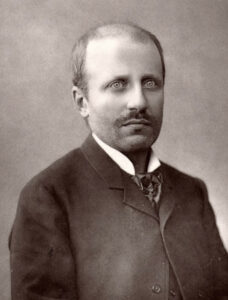
Philipp von Ferrary and His Collections
Although thousands of silver Geschichtstalers were made for circulation, each and every gold off-metal strike is unique, produced in 1902 using the historic original dies in the Bavarian State Mint in Munich. This is because these off-metal strikes were produced at the request and expense of one of the most famous collectors of the 19th century. Philipp von Ferrary was primarily known for his stamp collection, which is regarded as the largest and most valuable ever compiled. This stamp collection somewhat overshadows his coin collection, which is less well known – probably just because it wasn’t auctioned under his name.
Philipp la Renotière was born as Louis Philippe de Ferrari on 11 January 1850 in Paris. The Ferrari family was one of the ten richest families in the world at this time. Philipp’s father held three titles: Marquis de Ferrari, Duke of Galliera and Prince of Lucedio. His mother also came from old Genoese nobility. The family owned the Palazzo Rosso in Genoa with its famous art gallery, now one of the city’s best-known attractions thanks to said gallery.
However, it wasn’t his parents’ wealth that enabled Philipp von Ferrary to become such a prominent collector. He actually fell out with his father early on because the latter would not accept his homosexuality; he was then adopted by the Austrian Count de La Renotière von Kriegsfeld. He initially renounced his father’s inheritance, as he had some substantial capital of his own, acquired mainly through his investments in the Suez Canal. After his parents died, he vowed eternal faithfulness to his partner Albert Arnold in the chapel he had built by Lake Attersee and, from that point onwards, called himself Philipp Arnold. He would later be buried under this name in Steinbach am Attersee.
Despite his wealth, Philipp von Ferrary lived rather modestly. In the communities around Lake Attersee in Austria, he became known as a generous and approachable guest who was always willing to donate substantial sums for a good cause. He was popularly known as the “Geldschmeißer” (“money-slinger”), because wherever he went, he would throw coins to the children.
This wealth enabled Philipp to live out his dreams as a collector. He travelled to all the prominent stamp and coin dealers of his era, and would usually pay for his purchases right away and in gold. He was known for not bargaining when he wanted to buy something. And he had good links with mints, including the Bavarian State Mint, which, in the early 20th century, still housed the dies for many Bavarian coins. These dies were used to produce the gold off-metal strikes of Geschichtstalers now offered by Numismatica Genevensis.
Philipp von Ferrary, who had been granted Austrian citizenship, was actually planning to make his collections accessible to the public. But after his death on 20 May 1917, things turned out differently. France demanded Ferrary’s collections as part of the war reparations. They were included as individual assets in the Treaty of Versailles. From 27 to 31 March 1922, a part of his coin collection was auctioned at Sotheby, Wilkinson & Hodge in London without any mention of the collector’s name. This was also the case in the other auction catalogues, which means that we are unable to reconstruct Ferrary’s collection in every detail.
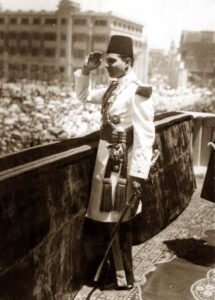
King Farouk of Egypt
The next great collector to own these impressive gold off-metal strikes was Farouk, who ruled the Kingdom of Egypt from 1936 to 1952. He was born on 11 February 1920 and followed his father as king at the age of 16. This meant that he now possessed, in addition to the royal title, a fortune worth 100 million dollars, more than 300 square kilometres of arable land in the Nile Valley, five palaces, 200 automobiles and two yachts. This was enough of a fortune to enable him to compile one of the most extensive coin collections of his time, mainly compiled in the 1940s. This collection consisted of 8,500 significant rarities, including the only legally exported 1933 Double Eagle, two specimens of the 1913 Liberty Head nickel, as well as the unique pattern of the 20 dollar Gold Eagle of MCMVII (1907), with the “Indian Head” designed by Saint-Gaudens on the obverse. The gold off-metal strikes of Bavarian Geschichtstalers, previously owned by Philipp von Ferrary, were therefore in very good company. King Farouk was both popular and feared among coin dealers due to his costly purchases; after all, every bill and receipt had to be processed by the Egyptian authorities, which could take a very long time.
In addition, after the Second World War, Egypt was the richest country in the Middle East, home to more than 500 millionaires, while the fellahin – the peasant labourers who worked the land – lived in extreme poverty. King Farouk himself was considered one of the richest men in the world. But when he proved unable to address Egypt’s social crisis, public acceptance of his rule declined dramatically. His extravagant lifestyle turned people against him. In 1952, there was an uprising. The army, led by Colonel Gamal Abdel Nasser, drove Farouk into exile. After his fall, the Egyptian government ordered the London coin dealerships Baldwin’s and Sotheby to auction off his coin collection. An impressive catalogue from 1954, comprising 2,798 lots and 37 plates, still testifies to the importance of this collection, which once included the magnificent ensemble of gold off-metal strikes of Bavarian Geschichtstalers that will now find a new owner at the Numismatica Genevensis auction on 14 November 2022.
For more details on the decadrachms of Kimon and the auction, see the Numismatica Genevensis SA catalog.
Here you can read a comprehensive auction preview.
For further information, visit the website of Numismatica Genevensis.
In this video you can learn more about Ludwig I’s history talers.
Ludwig I. made Munich his representative capital. Today the city is famous for its numismatic scene.


